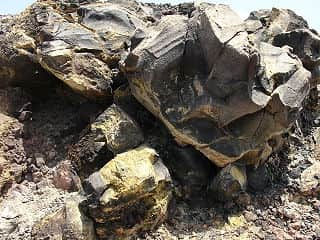What is H2S?
Have you heard of H2S? How about the acronym's definition, hydrogen sulfide?
Did you know that hydrogen sulfide is one of the leading causes of workplace gas inhalation deaths in the United States? Chances are you've been directly or indirectly exposed to this deadly gas in both your personal and occupational life, without even knowing it.

Hydrogen sulfide is also known as sewer gas, swamp gas, stink damp, and sour damp. It is a colorless gas known for its pungent "rotten egg" odor at low concentrations, and it is extremely flammable and highly toxic.
Hydrogen sulfide is used or produced in several industries, including:
- Petroleum production and refining
- Sewer and wastewater treatment
- Agricultural silos and pits
- Textile manufacturing
- Pulp and paper processing
- Food processing
- Hot asphalt paving
- Mining
Hydrogen sulfide can also occur naturally in sewers, manure pits, well water, oil and gas wells, and volcanoes.
Highly Hazardous
Hydrogen sulfide has several IDLH (Immediately Dangerous to Life and Health) characteristics. Because it is heavier than air, it can collect in low-lying and confined and enclosed spaces, such as utility access holes, sewers, and underground vaults. Its buildup makes work in confined spaces potentially dangerous. Atmospheric sampling prior to and during confined space entry is critical.
The health effects of hydrogen sulfide vary, depending on the quantity of H2S a worker breathes and the length of the exposure. However, many effects are seen even at low concentrations. Mild effects include headaches or eye irritation, and serious effects can lead to unconsciousness and death. NEVER RELY ON YOUR SENSE OF SMELL to indicate the continuing presence of hydrogen sulfide or to identify harmful levels. It can quickly, almost immediately, overcome unprepared workers, including rescue workers.
Worker Exposure Limits
IDLH limits for H2S are set forth by NIOSH, the National Institute for Occupational Safety and Health. NIOSH also sets forth RELs, or recommended exposure limits.
OSHA, the Occupational Safety and Health Administration, regulates PELs, or permissible exposure limits, based on ppm (parts per million) exposure levels for Hydrogen Sulfide.
Hydrogen Sulfide Worker Exposure Limits
NIOSH REL (10-min. ceiling): 10 ppm
OSHA PELs: General Industry Ceiling Limit: 20 ppm
General Industry Peak Limit: 50 ppm (up to 10 minutes if no other exposure during shift)
Construction 8-hour Limit: 10 ppm
Shipyard 8-hour limit: 10 ppm
NIOSH IDLH: 100 ppm
Notes. IDLH: immediately dangerous to life and health (level that interferes with the ability to escape) (NIOSH), PEL: permissible exposure limit (enforceable) (OSHA), ppm: parts per million, REL: recommended exposure limit (NIOSH)
Also, if worker exposure to H2S does occur, it's important to recognize symptoms that may develop based on the ppm concentrations. As you can see by the chart below, H2S concentrations of 100 ppm and higher can cause severe illness and death.
Effects of H2S
| Concentration (ppm) | Symptoms/Effects |
|---|---|
| 0.00011-0.00033 | Typical background concentrations |
| 0.01-1.5 | Odor threshold (when rotten egg smell is first noticeable to some). Odor becomes more offensive at 3-5 ppm. Above 30 ppm, odor described as sweet or sickeningly sweet. |
| 02-5 | Prolonged exposure may cause nausea, tearing of the eyes, headaches or loss of sleep. Airway problems (bronchial constriction) in some asthma patients. |
| 20 | Possible fatigue, loss of appetite, headache, irritability, poor memory, dizziness. |
| 50-100 | Slight conjunctivitis ("gas eye") and respiratory tract irritation after 1 hour. May cause digestive upset and loss of appetite. |
| 100 | Coughing, eye irritation, loss of smell after 2-15 minutes (olfactory fatigue). Altered breathing, drowsiness after 15-30 minutes. Throat irritation after 1 hour. Gradual increase in severity of symptoms over several hours. Death may occur after 48 hours. |
| 100-150 | Loss of smell (olfactory fatigue or paralysis). |
| 200-300 | Marked conjunctivitis and respiratory tract irritation after 1 hour. Pulmonary edema may occur from prolonged exposure. |
| 500-700 | Staggering, collapse in 5 minutes. Serious damage to the eyes in 30 minutes. Death after 30-60 minutes. |
| 700-1000 | Rapid unconsciousness, "knockdown" or immediate collapse within 1 to 2 breaths, breathing stops, death within minutes. |
| 1000-2000 | Nearly instant death |
OSHA Regulatory Guidance
Although OSHA does not currently have a standard dedicated to H2S, it has related information contained within several OSHA standards. Among them are:
General Industry:
- 29 CFR 1910 Subpart G- Occupational Health and Environmental Control:
- Section 1910.94- Ventilation
- 29 CFR 1910 Subpart H- Hazardous Materials:
- Section 1910.119- Process safety management of highly hazardous chemicals
- 29 CFR 1910 Subpart I- Personal Protective Equipment
- Section 1910.134- Respiratory Protection
- 29 CFR 1910 Subpart J- General Environmental Controls
- Section 1910.146- Permit-required Confined Spaces
- 29 CFR 1910 Subpart Z- Toxic and Hazardous Substances:
- Section 1910.1000- Air Contaminants
- Section 1910.1200- Hazard Communication also known as the OSHA Hazard Communication Standard (HCS)
- Section 1910.1450- Occupational exposure to hazardous chemicals in laboratories
There is also related H2S information contained within Construction (29 CFR 1926) and Maritime (29 CFR 1915, 1917, and 1918) standards.For more detailed information on H2S, please reference OSHA's Hydrogen Sulfide Safety and Health Topic page.

